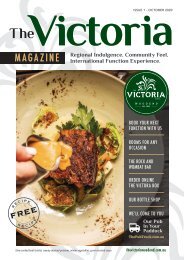Made Kindly Magazine by Zig Zag Rd Wines
Welcome to Issue 1 - Made Kindly Magazine by Harriet and Henry Churchill at Zig Zag Rd Wines. Visit zigzagwines.com.au
Welcome to Issue 1 - Made Kindly Magazine by Harriet and Henry Churchill at Zig Zag Rd Wines.
Visit zigzagwines.com.au
- No tags were found...
You also want an ePaper? Increase the reach of your titles
YUMPU automatically turns print PDFs into web optimized ePapers that Google loves.
The vines will be sharing their captured sugars with the<br />
fungi under the ground, and in exchange the fungi will be<br />
giving minerals and nutrition back to the plant.<br />
This is a particularly important process in the way we’re<br />
farming: we don’t use synthetic fertilisers, and instead rely<br />
on the biology below ground to support the plants growth and<br />
wellbeing. Rather than using chemicals, we spray food for the<br />
fungi and microorganisms: molasses; fish kelp; whey; nettle;<br />
humates; citrus <strong>by</strong> products and compost, amongst other<br />
things.<br />
We’re going through the vineyard and pushing up the canes<br />
into the foliage wires to allow the dappled sunlight to hit<br />
the berries, and to make sure our organic sprays get good<br />
coverage over the foliage.<br />
It’s a time friends come to stay and help out with the work.<br />
Hard days out in the vines, with beautiful evenings watching<br />
the sunset over the vineyard, with a glass of wine.<br />
It’s thriving and colourful.<br />
APRIL<br />
It’s a very beautiful time at the vineyard,<br />
with the foliage on the ornamental vine<br />
around the cellar door in its full red glory.<br />
This is the time when we’ll plant a cover<br />
crop in the mid rows, as part of our<br />
regenerative practice.<br />
We’ll bring in the sheep (and in the future<br />
ducks and geese), and intensively graze them<br />
in accordance with regenerative practises -<br />
using cells to move them through the vineyard<br />
like herd animals. They’ll gobble up the<br />
grasses and weeds, trample down the organic<br />
matter so it touches the soil, and poop out<br />
natural fertiliser for the bugs and microbes.<br />
Wine making continues. The wines will be<br />
going through their process of fermentation,<br />
and we’re constantly tasting and analysing.<br />
FEBRUARY<br />
Hot and dry. Similar processes as January, but now the<br />
berries are going through veraison (green, hard and sour, to<br />
purple, soft and sweet) and the birds will be circling<br />
It’s a time of nets!! This is a big, fun, job. Before the<br />
berries turn purple, we haul huge nets over the rows of<br />
vines. We clip up the holes and put out the bird scarer. We<br />
sit with our breakfast every morning, peering at the crows,<br />
galahs, cockatoos, silver eyes, and other birds working out<br />
how to pilfer our livelihood.<br />
We’re constantly walking the vineyard to check ripeness of<br />
the grapes, estimating the harvest, and pulling back down the<br />
nets that have blown over in the summer winds (including huge<br />
willy willy’s).<br />
We can feel harvest around the corner. Preparations afoot.<br />
The winery is being reorganised, putting the bottled wine<br />
into cool storage, and making space for the equipment we<br />
need.<br />
MAY<br />
The Macedon Ranges is in one of its most<br />
beautiful seasons, with the leaves turned<br />
and falling, and often still, warm days and<br />
chilli nights. We’ll start looking at the<br />
fireplace.<br />
We’re finishing off the wine making, and<br />
starting the process of cleaning up after<br />
the season. Nets in, winery cleaned, fences<br />
and foliage wires fixed. We’re tasting and<br />
drinking the wine, topping up barrels, and<br />
starting to plan for the bottling of the<br />
white wines.<br />
Wood will be chopped from the paddocks, and<br />
red gum brought in.<br />
The pace is starting to slow a little, and<br />
hikes, coffees, and friendships abound.<br />
MARCH<br />
The waiting game. We need sunshine and not much rain, to<br />
ripen the berries. They’re all red now and the sugars,<br />
flavours and tannins are developing.<br />
It’s at this time of year when the birds are at fever pitch,<br />
desperate to eat the juicy berries.<br />
JUNE<br />
The wine is made, and the temperature is<br />
falling. The vineyard is resting.<br />
And so are we.<br />
Vintage starts. We’re constantly analysing the grapes to<br />
check for ripeness: how do they taste (generally, if they<br />
taste good, the wine will be good)? What is their sugar<br />
content? (measured in brix or baume)? What is their acid<br />
content (measured with a ph reader)?<br />
Lots of heaving, and forklifts, and early mornings. Stress<br />
and joy. Equipment breaking and quick solutions found. Every<br />
wrong step can ruin the whole year’s work, and a lot is at<br />
stake.<br />
The ferments start naturally, which means there’s a nail<br />
biting 3 or 4 days waiting for the indigenous yeasts to start<br />
their work. If it takes longer, the grapes can spoil.<br />
Our hands (and sometimes feet) are bright red, no matter how<br />
much we wash. The energy is frenetic, but it’s a rich, alive<br />
time. We sometimes take the nets off late at night, when the<br />
birds are asleep, under the bright moon and a billion stars.<br />
The beauty can slap you to tears.<br />
11

















